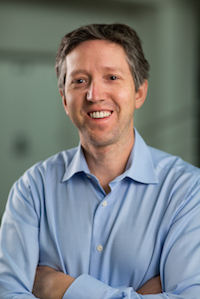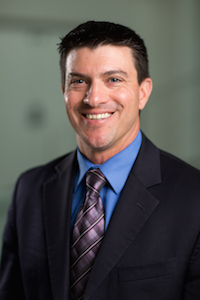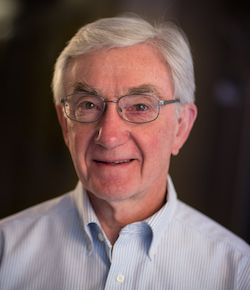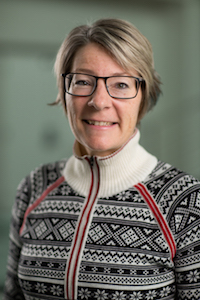
Author: Julie Kiefer
A boy’s love of the ocean draws him to a profession of drug discovery. A farm girl’s relentless work ethic brings her adult medical skills to places she never imagined. A Chinese linguist drawn to computer linguistics reveals worlds of valuable medical data hidden within doctor’s notes.
Inspiration comes from unexpected places, a theme that reverbrated throughout Vitae, the Office of the Senior Vice President for Health Sciences Research Unit's hallmark event recognizing research excellence across University of Utah Health.This year’s symposium spotlighted six star faculty who captivated the crowd with stories of their science, and how they got to where they are today.
Eric Schmidt, PhD, Professor, Medicinal Chemistry

The Language of the Microbiome
Chemistry is the language of life. It is how organisms communicate with each other, compete with each other, and live with each other, especially at the microbial scale. It sounds strange to say, but I’ve been fascinated with the chemistry of symbiotic bacteria for as long as I can remember. How can a young child even know about this? I remember clearly a moment when submarines discovered a whole new world of animals living on the edge of undersea volcanoes. There, amazing tubeworms thrived using the chemistry of their symbiotic bacteria. That is part of what propelled me into a career studying the chemistry of symbiotic bacteria as they interact with animals. It turns out that bacteria are everywhere, and they contribute key molecules that are important for animal health and survival. By studying those interactions, we can discover potential drugs, tools, and processes and apply them to human health.
Barbara Jones, MD, MSCI, Assistant Professor, Internal Medicine

Messy Jobs: Learning from Experience to Understand Clinical Decision-Making in Pneumonia
Have you ever seen pigs eat? As children, my three sisters and I fed them every day as one of our jobs on our farm in Minnesota. It was very hard, messy work, but it was as fun for us as it was for the pigs. Since then, I have been drawn to working in messy jobs: learning from experience, collaborating with others, and operating at the intersection of theory and practice.
Clinical decision-making in pneumonia is also messy. Providers must integrate large quantities of information to diagnose and treat patients, often under time pressure and with serious, uncertain consequences. Widespread variation in practice and outcomes exist despite availability of evidence-based practice guidelines generated by the best academic hospitals and pneumonia experts. However, there is also wisdom in practice. Recent advancements in electronic health records allow us to examine variation and develop new ways to learn from each healthcare experience, generating evidence that includes previously underrepresented patients, settings, and scenarios and bringing it closer to real practice.
Matthew Rondina, MD, MS, Associate Professor, Internal Medicine

Platelets: Beyond the Clot
Platelets are one of the few human cells that can live and function without a nucleus. For decades, platelets were thought to be merely cell fragments with limited functions, primarily blood clotting. Based in part on discoveries made at the University of Utah, platelets are now recognized to have very dynamic—in some cases long-lasting—roles spanning hemostatic, inflammatory, and immune responses. Platelets serve as sentinel and effector cells during acute and chronic inflammatory diseases. My lab’s research focuses on understanding how inflammatory triggers reprogram gene expression in platelets and their parent cells, called megakaryocytes. By understanding the molecular mechanisms governing gene expression, we aim to contribute to new therapies targeting dysregulated inflammatory responses that cause host injury.
Erhu Cao, PhD. Assistant Professor, Biochemistry

Structures and Mechanisms of Renal Ion Transporters and Channels
I am broadly interested in understanding atomic-scale mechanisms of how membrane proteins function under normal and diseased states. In particular, my lab focuses on the structures, physiology, pathology, and pharmacology of receptors, transporters, and ion channels that play pivotal roles in the kidney. When those structures and mechanisms malfunction, they cause various diseases in humans. In one recent study, we determined structures of PKD2, an ion channel that is often mutated in polycystic kidney diseases (PKD). PKD is a common life-threatening genetic disorder that affects about 12.5 million patients worldwide. Our PKD2 structures revealed that PKD2 resembles many ligand-gated ion channels in having a large extracellular domain that could be potentially targeted for therapeutic interventions. We also aspire to develop pharmacological tools mainly for dissecting structures and functions of ion channels and receptors, but also as drug leads for developing novel therapeutic strategies.

Dana Carroll, PhD, Professor, Biochemistry
Changing Genes for Better or for Worse
My career has encompassed many of the technological breakthroughs of molecular biology: recombinant DNA, PCR, DNA sequencing, molecular structure determination, high-resolution imaging, and now genome editing. The modern understanding of nature has been built on these and other discoveries. Seeing how new questions and paradigms have evolved has been astonishing. My group continues to work on very basic issues regarding how genome editing works. We have particularly emphasized CRISPR, with the goal of enhancing its capabilities. I am also interested in societal issues surrounding the use of this new technology, particularly in medicine and agriculture.
Wendy Chapman, PhD, Professor, Biomedical Informatics

Making Sense of Doctor's Notes with Natural Language Processing
What do a health services researcher, a clinician, and a public health official have in common? They all want information about patient symptoms, risk factors, and diagnoses stored in the Electronic Health Record (EHR). This information has the potential to help identify disease outbreaks, answer questions about treatment efficacy, predict patients at risk for readmission, and identify families with unusual phenotypes. Unfortunately, most of the information about patient visits is locked in text and is inaccessible except through browsing and reading. Natural language processing (NLP) can extract information from text automatically.